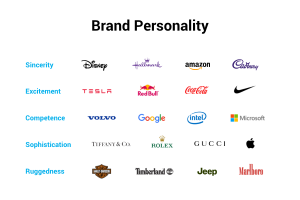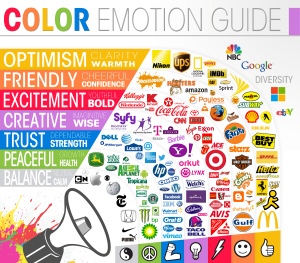
Today, the use of branding as a strategic tool is becoming more and more important for business. Companies are, to a greater extent, realizing the benefits of building brand identity. Brand identity is a philosophy you embrace and the culture you adhere to. It is a feeling that a business evokes in its customers. But, a brand isn’t built overnight. It takes time. And more often than what we might think, it needs a little push in the right direction from your side. That’s why we have put together this guide on the ways to build a successful brand identity:
1. Define your brand identity
Just like people, brands too have their identities and personalities. So, before diving into the process, ask yourself, if your company was a person, who would it be? How would she act, talk or dress? For instance, brands such as Rolex aim for sophistication.
Brand identity and personality refer to the personification of a brand. It plays a vital role in developing and maintaining strong brands by assigning a set of human characteristics and qualities to the brand. Defining a brand identity makes it immediately recognizable and creates an emotional connection. There are five main types of brand personality:
Competence: successful, accomplished and leadership
Sincerity: thoughtfulness, family values and kindness
Excitement: youthful, spirited and carefree
Sophistication: pretentious, elegant and prestigious
Ruggedness: tough, athletic and outdoorsy

Image source: https://uploads-ssl.webflow.com/5de2db6d3719a1e2f3e4454c/5de41ea93719a1c579eb990c_brand-personality-examples-famous-brands.png
2. Understanding your purpose
Why are you in the business? Yes, I’m sure you’d like to turn a profit out of it, but that’s not the type of purpose that’s going to help you understand and establish the purpose of your brand. This has to go beyond the services and products that you’re offering. The development process brings in the purpose of understanding the ritual of brand building which is open but difficult to follow. What are your brands’ vision and mission? In its essence, you will have to craft a clear purpose of what you and your brand are passionate about. This is your why, the reason you get up every day.
Before you can build a brand identity for a target audience that trusts your brand, you will need to know what value your business provides and understand your purpose. For this, envision a projection of where your brand pioneers to go and what impact it will make. Everything you do to build your brand, logo, tagline or typography should reflect the purpose of your brand. For instance, we all know the Nike tagline, Just Do It. But do we know the purpose behind this mission statement? Nike’s purpose is to bring inspiration and innovation to every athlete in the world.
3. Research your peers
Competitive analysis can be a helpful first step towards developing any marketing strategy and brand identity is no exception. The branding lessons you can derive from your peers can vary eloquently according to your industry and the level of competition you are facing. Customers aren’t looking for another cookie-cutter company that offers the same thing as everyone else so let your brand personality shine among others.
Your peers can either be textbooks of poorly defined brand identity having little-to-no consistency across digital platforms with a primordial logo. Perhaps they have an excellent brand identity that is unique and memorable. Regardless of where your peers stand, use their statuses as a prime point to create your objectively better brand identity.
4. Target your audience
So, who is your prime audience? What are their goals and desires? What challenges and problems do they face? How does it impact them internally? It’s essential to know your audience because you will need to know how to resonate with them. Know your audience in terms of demographics and psychographics as well. So you’ll need to uncover the details about their lives and explore the personal side of their lives and what makes them tick.
The primary goal of branding should be that every potential customer knows exactly where you want to take them. The factor that leads to customer conversions and prospect trust can provide important clues to your brand identity. Your brands’ unique trust factor could be transparency, flexibility or expertise. Use this trust factor as an essential tool in targeting your audience and defining why your brand is different from them and helps in building an appealing brand identity.
5. Choose your brand name
Choosing a brand name is one of the crucial components of branding. The brand name extends your business and can reinforce the value you provide with your product or service. It’s vital to decide what your name should mean and represent. For this, you will need to determine what your name needs to accomplish, decide how it will work with an existing product or service and then choose a unique brand name. Your name must fit your company- not necessarily by describing what you do but by capturing the essence of who you are. When you begin brainstorming brand names, ask yourself what your values are and what makes you different.
Your brand name is the first detail consumers learn about your brand and if you get it wrong, you could lose their loyalty before they even try your product or service. It should be authentic, distinctive, memorable and enduring. Brand name should resonate with your target audience, stick in their minds, build and maintain trust with them, and remain relevant as your business evolves. While resonating in the minds of your customers, choose a brand name that clearly communicates what your brand is about. A strong brand name should be distinct, especially within your industry.
6. Design your picturesque
First impressions can either break or make your business. Picturesque is everything when it comes to first impressions. The design of your website, the colors, the layout and the aesthetics of your brand persuade visitors to take the desired action on your website. Once you have got your brands’ name you’ll need to think about how you’ll visually represent your brand. This includes three main things, colors, fonts and logos.
Color- Your color choices are key to evoking emotions and differentiating your brand. Think of McDonald’s golden arches and how they stand out and did you know that Tiffany trademarked its color so that no other jewelry brand can use it? Here is a color emotion guide depicting renowned brands:

Image source: thelogocompany.net
Logo- Your logo is the cornerstone of your brand identity. It is your company’s most immediate visual representation- think of Apple’s logo with a bite out of it.
Font- A consistent typeface is a key to instilling familiarity. Think of the New York Times’ use of Georgia that gives it a classic look or maybe you want your brand to appear sleeker and modern like Google.
7. Define your brand voice
This is the part where you define your brand’s persona, including your tone of voice and tagline. You should focus on making a human connection with your targeted audience. Brand voice plays an important role now more than ever, because you see, back in the 80s and 90s consumers didn’t have much to say. There were no social media, so brands communicated with one-way broadcast messages in the form of advertisements, and if the consumer didn’t feel a connection or had a complaint, they basically had no voice.
Things are much different now. Word of mouth is leveraged by social media, meaning consumers have a voice and are well aware they do speak up. Consumers expect brands to have a personality, a voice so that they feel like they are engaging with a person when they are engaging with your brand. Branding cannot be fully defined without defining your brand’s voice and creating a human brand persona. This will allow you to form your brand attitude and express your personality.
8. Create a brand guide
Launching a new brand identity is all dependent on a solid brand guide. It takes upon different brand elements, almost everything we have discussed so far, translating them into tangible rules and standards. At the heart of your brand guide is what we like to call the ‘special sauce’ of your brand, the stuff that makes you uniquely you and shapes your strategy. You will need to include approved versions and lockups of your logo, color palettes, typography, image library, tone of voice, and even specific brand touchpoints.
Your target audience, mission statement, positioning statement and brand personality should be there. These are the elements that should be outlined at the beginning of your guide so that people within your organization can contribute to making decisions that are ‘on brand’. As your brand evolves, so will your guide. So keep updating it with changes, upgrades or new information. Nowadays, brands tend to go for a digital form of brand guidelines by having a dedicated website.
9. Create brand touchpoints
Most branding projects will require the design of a website, stationery web portals and social media graphics. Every single piece of collateral must work together to deliver a clear yet strong brand image. Each touchpoint is an opportunity to increase awareness and build customer loyalty. This is the part to take the brand elements (colors, fonts and voice) and use them consistently. So that regardless of how your customers interact with your brand, they have a seamless experience.
Brand touchpoints are simply ways in which your brand interacts with people. Not every brand will require every single of them. Your needs will depend on many factors, including your product or service and your targeted audience. Most businesses and companies develop at least several brand touchpoints to reach their audience. Most common is a web platform where brand identity, consistent typography, corporate colors and unique voice come through in full force. Another is a social media presence, which is a great opportunity to connect with your targeted audience more personally. Here are a few thumb rules to create unique brand touchpoints:
- Be different
- Be durable
- Be authentic
- Be evolutionary
10. Know your four P’s
The four P’s of brand marketing are Product, Price, Place and Promotion. These are the key elements in marketing a product or service as they interact significantly with each other. Considering all of these elements is one way to approach a holistic marketing strategy. It can be used when you plan a new business venture, test your marketing strategy, or optimize your sales with your target audience. Brands can ensure they have a visible presence and competitively priced service and promoted to their targeted audience.
Product refers to the services or products your brand provides to your targeted audience. It can vary depending on the type of company and what they do. For instance, McDonald’s provides consistent fast food, whereas Salesforce provides customer relationship management (CRM) software and marketing automation tools for business.
Price refers to how much you cost for your service or product. It depends on your competitors, demand of the service, cost to produce the product and what your targeted audience is willing to spend. Brands will also need to consider their pricing models, including choosing between subscription models or one-time purchasing.
Place refers to how and where your audience will consider your services or buy your product. This includes places such as online via a web browser, an application or a retail location. You can reach your audience through trade shows or events, through marketplace channels such as Walmart or Amazon or a sales executive.
Promotion refers to strategic and thoughtful advertising that reaches your brand’s targeted market and audience. As a brand, you can carry on a PR campaign, an Instagram campaign that showcases your services or an email campaign to reach out to your audience at the right place and right time.
11. Marketing and SEO
Marketing your brand is how businesses and organizations highlight and bring light to their products and services by aligning values and strategies to the targeted audience. The amplification of your brand can be done through various digital marketing activities such as user experience, social media marketing, email marketing, paid advertising, content marketing and SEO. Altogether, these channels are fundamentals to gaining brand awareness and growth.
Be prepared to adapt and change with your brands’ SEO needs. Your branding strategy of today might not be effective tomorrow. Digital Marketing is essential because brands change based on their industry and market trends. Even potential company mistakes could force you to rebrand your business. Some of the most popular brands in the world have rebranded themselves for a wide range of reasons. Nike never sold basketball sneakers until they signed Michael Jordan. Today, they sell the most basketball shoes in the world, all because of strategic marketing.
Takeaway
As Steve Jobs states, your brand is the single most important investment you can make in your business. Your business will be just another faceless and nameless organization without branding. Survival will be a struggle and people won’t be able to pick you out of the adverse competition out there. Building a brand identity can do incredible things for your business. It can allow you to increase your prices and establish trust with your clients, making them come back to you for more. Your brand is your identity as well as your reputation and that is why you need to take the right steps to build a brand identity.